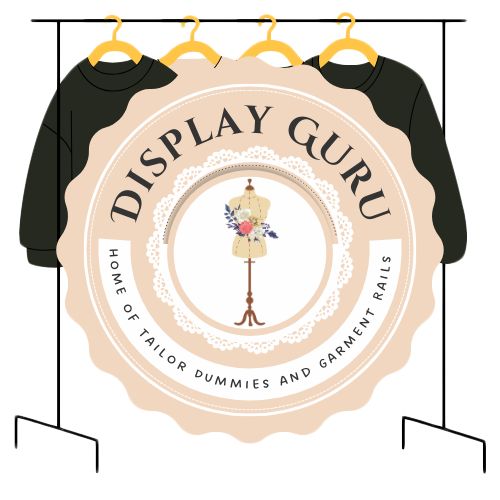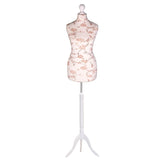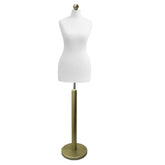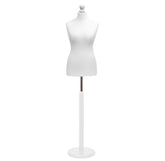Half Scale Mannequin Mastery: Your Display Success Guide
Understanding Half Scale Mannequins Without The Industry Jargon
Let's cut through the technical terms and get straight to what a half scale mannequin really is. Think of it like a baker's toolkit. A full-sized mannequin is like a magnificent, three-tiered wedding cake—impressive, but it demands a lot of ingredients, time, and space. A tiny doll-sized form is like a single cupcake—charming, but it can't quite capture the complexity of the full design.
A half scale mannequin is the perfect single-tier cake. It allows you to practice and display all the same techniques, textures, and decorative elements as the grand wedding cake, but in a much more manageable and cost-effective way. It’s a practical tool, not just a smaller version of something else.
This scaled-down model is more than just a space-saver; it's a specialised instrument with its own set of benefits. For fashion students, it means being able to draft and test patterns using 50% less fabric—a considerable saving over a term. For boutique owners with limited floor space, these forms can create eye-catching window displays in spots where a full-sized dummy would look cluttered.
Discovering The Right Style For Your Needs
The name "half scale mannequin" actually describes a family of different forms, each designed for specific purposes. You're not just getting one standard model. The main styles you'll come across are:
- Torso Models: These are perfect for showcasing tops, blouses, necklaces, and scarves. As the most common type, they put the focus squarely on the garment itself without any distractions.
- Full-Body Versions: Though less frequent, these forms give a complete view of an outfit, including trousers or skirts. They are great for creating dynamic, lifestyle-focused displays within a compact area.
- Adjustable Forms: Certain models come with built-in dials or mechanisms to alter key body measurements, giving you extra flexibility for pattern making and fitting different sizes.
The growing use of these versatile tools is reflected in market data. The UK mannequin sector, which includes the popular half scale mannequin, generated revenues of about USD 278.2 million in 2023. This number is expected to climb, which shows how many designers and retailers are recognising their practical value.
The trick is to view them not as a compromise, but as essential pieces of equipment that offer new ways to design and present fashion.
Where Half Scale Mannequins Actually Make A Difference

The true worth of a half scale mannequin becomes obvious when you see it solving problems that full-sized forms just can't handle. These aren't simply scaled-down statues; they are precision tools for environments where space, cost, and efficiency are top priorities. They offer a practical edge in several key areas, turning constraints into creative opportunities.
The Boutique Retailer’s Secret Weapon
Picture a small, independent boutique where every square foot of floor space is precious. A vintage clothing shop, for example, might want to create a stunning window display but simply doesn't have the room for three full-sized mannequins. By using a trio of half scale models, the owner can layer outfits, tell a visual story, and showcase multiple items without cluttering the entrance.
This strategy can effectively double the visual impact in a tight space, attracting customers with a display that feels curated and dynamic, not cramped. These forms are also perfect for countertop displays, allowing retailers to bring key accessories or garments closer to the customer's line of sight.
This is especially true for presenting delicate or detailed items. In the UK market, the half scale mannequin has found a major role in jewellery retail, an industry where precision and focus are essential. Small forms allow necklaces, brooches, and body chains to be displayed elegantly without getting lost on a larger frame. In fact, jewellery presentation makes up about 35% of the mannequin market’s application share, showing just how important the right-sized display is. You can find more data on the mannequin market and its applications.
The Fashion Designer's Prototyping Partner
In the fast-moving world of fashion design, the path from a concept sketch to a finished pattern can be long and expensive. This is where the half scale mannequin proves its value as a trusted partner. Fashion design students and independent designers use them to:
- Test Complex Drapes: Working with difficult fabrics or intricate draping techniques on a smaller scale cuts down on material waste and allows for faster adjustments.
- Refine Pattern Pieces: Drafting and altering patterns at half the size is quicker and uses less paper and fabric, making the whole development process more efficient.
- Visualise Proportions: Seeing a design come to life in three dimensions, even at half scale, gives a much clearer sense of proportion and fit than a flat sketch ever could.
For fashion schools, giving each student a personal half scale form is much more affordable and space-saving than providing full-sized ones. This not only makes practical sense but also improves the quality of student projects and presentations.
Choosing Your Half Scale Mannequin Without Buyer's Remorse
Picking out the right half scale mannequin isn't about falling for a sales pitch; it's about looking at the practical details that will genuinely affect your work. Think of it as matching the tool to the specific job. A boutique owner needs an elegant display, while a design student needs a versatile workhorse for countless projects. The choice of material, for example, is more than a question of durability—it changes how garments hang, how light interacts with the surface, and how the form holds up to daily use.
Material Choices That Actually Matter
The material of your half scale mannequin is a fundamental decision that sets the stage for everything else. A frequent misstep is to choose based on price alone, ignoring the day-to-day reality of using it. A lightweight plastic resin form might seem convenient, but you may find it struggles to hold the weight of heavily draped fabrics. On the other hand, a solid wood composite model gives you excellent stability but can be a hassle to move around a busy studio.
Understanding these trade-offs is crucial for making a smart investment. For designers who need to create patterns for various sizes, a polystyrene body with a fabric cover offers a surface you can easily stick pins into. This is a feature you can explore in more detail in our ultimate guide to adjustable mannequins for sewing.
This decision tree helps you select a material based on the property you value most.
The infographic simplifies the process, showing that if maximum durability is your goal, wood composite is the best choice. If you need something lightweight and portable, plastic resin is your go-to.
To give you a clearer picture, here's an honest comparison of common materials, focusing on how they perform in the real world.
Half Scale Mannequin Material Reality Check
Honest comparison of materials based on real-world performance, including what works best in different situations and actual longevity expectations
| Material | Real-World Durability | Actual Cost Range | Best Situations | Maintenance Reality |
|---|---|---|---|---|
| Fibreglass | High. Resists chips and cracks well but can shatter on heavy impact. | £100 - £250+ | Retail displays, permanent studio setups, professional draping. | Low. Wipes clean easily. Be careful to avoid drops onto hard floors. |
| Plastic Resin | Moderate. Lightweight and flexible but can warp or discolour over time with sun exposure. | £60 - £150 | Student projects, pop-up shops, portable displays, photography. | Low. Prone to scratches. Keep away from direct sunlight and heat sources. |
| Wood Composite | Very High. Extremely sturdy and stable, resists daily wear and tear. | £150 - £300+ | High-end boutiques, permanent atelier fixtures, heavy garment work. | Low. Can be heavy and difficult to move. Susceptible to moisture damage if not sealed. |
| Fabric-Covered Polystyrene | Moderate to Low. The foam core can degrade with heavy, repeated pinning. | £70 - £180 | Pattern making, student use, draping where pinning is essential. | High. Fabric cover can get dirty or snag. Foam can lose its "pinnability" in high-use areas. |
This table shows that while a wood composite mannequin is a bigger initial investment, its durability makes it a long-term asset for a professional studio. In contrast, a plastic resin model offers affordability and portability, perfect for a student's budget and changing needs.
Features That Justify The Cost (And Those That Don't)
Beyond the core material, some features add real value, while others are just costly extras. Take the stand, for instance. A heavy, ornate base might look impressive, but it provides little functional benefit over a simple, sturdy tripod stand for a design student focused on draping.
Here are the features that often justify a higher price tag:
- Pinnable Surfaces: A half scale mannequin with a body you can stick pins into is non-negotiable for draping, pattern making, and fittings. A model that isn't fully pinnable will quickly become a source of frustration.
- Realistic Proportions: An accurately scaled body form is vital. A well-proportioned model ensures your half-scale designs will translate correctly when you create the full-size garment.
- Quality Finish: Look for a smooth, snag-free fabric cover or a chip-resistant paint finish. This protects your delicate fabrics and keeps your workspace looking professional over time.
By concentrating on these practical points—material, essential features, and accurate proportions—you can choose a half scale mannequin that will be a dependable partner in your creative process, not an expensive mistake.
Making Your Half Scale Displays Actually Work
Having a half scale mannequin is one thing, but turning it into a display that genuinely gets results is another challenge entirely. Without a clear plan, well-intentioned displays can end up looking more like an afterthought than a professional presentation. The secret lies in overcoming the smaller proportions by applying proven visual merchandising techniques to make your garments shine. It all starts with giving your miniature form the same strategic attention you would a full-size mannequin.
This means going beyond simply draping a garment over the form. Consider how lighting, positioning, and styling can work in harmony. A single, well-aimed spotlight can make a small display command attention from across a room, highlighting intricate details that might otherwise go unnoticed. This is particularly effective for showcasing jewellery or accessories on a half scale mannequin torso, transforming a basic countertop into a high-value feature.
Styling and Positioning Strategies
To create a display that feels purposeful, you need to think carefully about its composition. The main objective is to prevent the display from looking small or lost, especially within a larger retail environment. Here are some hands-on techniques to make your half scale displays more impactful:
- Create Groupings: Avoid leaving a single half scale form on its own. Grouping two or three together at different heights creates a more dynamic scene that tells a visual story and has a stronger presence.
- Use Risers and Props: Place your mannequin on a riser, a stack of vintage books, or an elegant box. Lifting the form brings it closer to eye level, giving it more authority and making it more noticeable.
- Mind the Background: Check that the backdrop enhances the display instead of competing with it. A cluttered background will overwhelm a small form, whereas a clean, contrasting colour will help it stand out.
- Perfect the Fit: Garments need to be styled with precision. Use pins and clips discreetly at the back to create a flawless fit that showcases the clothing's intended silhouette. A messy fit is much more obvious on a small form.
Upkeep and Seasonal Rotations
At the end of the day, a display is only as good as its maintenance. Dust and scuff marks can make even the most beautifully styled mannequin look unprofessional. Regular cleaning, tailored to the mannequin's material, is crucial. For more detailed advice on stand assembly and general care, take a look at our complete display success guide for a mannequin with a stand.
It's also a good idea to set a schedule for seasonal updates to keep your displays looking fresh and current. A simple accessory swap—like adding a winter scarf or a summer hat—can completely alter the look without needing a full redesign. This structured approach makes sure your half scale mannequin remains a consistently effective asset for your business.
Getting Real About Half Scale Mannequin Costs
 Let's talk about the real figures. The financial appeal of a half scale mannequin isn't just about its lower price tag compared to a full-size model. The true savings appear in the day-to-day workflow of a design studio or the clever merchandising of a retail space. By looking at the complete cost picture, you can make a purchase that delivers value long after the initial payment.
Let's talk about the real figures. The financial appeal of a half scale mannequin isn't just about its lower price tag compared to a full-size model. The true savings appear in the day-to-day workflow of a design studio or the clever merchandising of a retail space. By looking at the complete cost picture, you can make a purchase that delivers value long after the initial payment.
The most obvious saving, particularly for designers and students, is the reduction in material usage. Creating a prototype on a half scale form requires 50% less fabric, calico, and pattern paper. Across an entire collection or a single academic year, this can add up to hundreds of pounds, freeing up funds for other parts of your business or studies.
Calculating Your Return on Investment (ROI)
For retailers, the ROI calculation is different but equally persuasive. A small boutique could choose three half scale models over one full-size mannequin. This arrangement lets them showcase a complete, layered outfit in a compact window display, which could attract more customers and boost sales without the expense of a larger form. Creating more engaging displays within the same footprint offers a direct return.
However, there can be hidden costs that might take you by surprise. While the mannequin itself may be affordable, choosing a cheap, low-quality stand could lead to damage and the need for a replacement, wiping out any initial savings. For a more detailed look at display tactics and industry updates, you can explore more insights on the Display Guru blog. This can help you manage your entire display budget more effectively.
Bulk and Rental Considerations
When planning your purchase, keep these options in mind:
- Bulk Purchasing: For fashion schools or retailers organising a large-scale setup, buying in bulk can substantially lower the cost per unit. Many suppliers provide discounts for orders of five or more.
- Rental Options: If you only need mannequins for a one-off event, such as a trade show or a pop-up shop, renting can be a very sensible financial choice. It provides a professional appearance without the long-term storage and ownership responsibilities.
Ultimately, deciding if a premium feature is worth the price depends on your main purpose. A professional designer will quickly recognise the benefit of a fully pinnable model. In contrast, a retailer might focus on an elegant, sturdy stand for a better long-term aesthetic in their shop.
The Evolution of Half Scale Mannequins Beyond Basic Displays
The world of retail and design moves quickly, and the classic half scale mannequin is right in the middle of some exciting changes. No longer just static props for draping fabric, these forms are becoming interactive tools. Retailers and designers are blending them with digital technology, creating a mix of physical and virtual presentation that captures customer attention in new ways.
Imagine a shopper pointing their phone at a half scale display. Instantly, an augmented reality (AR) app shows them the garment in different colours or even projects a full-size version onto their screen. This isn't a futuristic concept; it's a real-world application that brings the efficiency of a half scale mannequin into the digital era. The growth of e-commerce is a major driver behind this, especially in the UK, where these smaller forms are perfect for efficient product photography and building virtual showrooms. You can find out more about this trend in this comprehensive market report.
From 3D Printing to Smart Sensors
Personalisation is another huge area of development. The accessibility of 3D printing is removing old barriers to customisation. Designers and brands can now create their own half scale forms with specific poses or body shapes that align perfectly with their brand's identity. This level of tailoring was almost impossible just a decade ago. Our guide on using plus-size mannequins for inclusive displays highlights just how important it is for modern retail to reflect diverse body shapes.
Beyond custom forms, technology is making these mannequins smarter. Some are now fitted with discreet sensors that track how customers interact with displays. These sensors can measure:
- How many people stop to look at a specific display.
- How long they spend observing it.
- Which particular items on the mannequin capture the most attention.
This information provides visual merchandisers with solid feedback on what works and what doesn't. It allows them to fine-tune their strategies based on actual customer behaviour, not just intuition.
To better understand these changes, let's compare the features of traditional half scale mannequins with their modern counterparts. This table offers a clear look at what has changed and whether the new features are a worthwhile investment for your needs.
Traditional vs Modern Half Scale Mannequin Features
Real comparison of what you get with traditional options versus modern innovations, including honest assessments of which upgrades are worth the investment.
| Feature Area | Traditional Options | Modern Innovations | Practical Benefits | Investment Reality |
|---|---|---|---|---|
| Material & Form | Standard fibreglass or linen-covered foam on a generic, idealised body shape. | 3D printed custom shapes, eco-friendly composites, pinnable surfaces. | Perfectly match brand aesthetics, support sustainable practices, easier for draping. | Worth It. Custom forms are a game-changer for brand identity and fit development. |
| Interactivity | Completely static. A passive display for clothing. | Augmented Reality (AR) integration via QR codes or markers on the mannequin. | Customers can see different colours/sizes on their phones, bridging physical and digital. | Situational. Excellent for high-tech retail environments but may be overkill for a small studio. |
| Data Collection | None. Relies on visual observation or sales data for performance analysis. | Embedded smart sensors to track customer dwell time and interaction points. | Provides concrete data on which displays and items are most engaging. | For Big Retailers. A powerful tool for optimising visual merchandising at scale, but a significant investment. |
| Purpose | Primarily for pattern making, draping, and basic in-store display. | Functions as a physical display, a digital content creator, and a data-gathering tool. | A single asset serves multiple roles, from design to marketing and sales analytics. | High ROI. A modern mannequin can justify its cost by contributing to more areas of the business. |
In short, the modern half scale mannequin is much more than a simple display piece. The blend of physical form with data analytics is changing how businesses approach product presentation. It represents a major shift from a passive prop to an active tool that helps you understand your customers and improve your sales.
Keeping Your Half Scale Mannequins Looking Professional
Your half scale mannequin is more than just a display item; it's a professional tool. Like any valuable asset in your design studio or boutique, it needs regular care to keep it looking its best and functioning correctly. Overlooking maintenance can be a costly mistake, potentially leading to permanent damage and the need for a replacement.
Imagine a boutique owner using a standard household cleaner on a fibreglass form, only to find it has caused permanent discolouration. This simple error can instantly make a premium display look cheap. By establishing a straightforward but consistent care routine, you can sidestep these issues and ensure your mannequin has a long and professional life. The key is to understand that different materials require different cleaning methods.
Cleaning and Handling Best Practices
To protect your investment and keep it in top condition, it’s vital to use the right approach for the right material. Here are some specific guidelines:
- Fabric-Covered Forms: These mannequins can easily pick up dust and smudges. A lint roller is perfect for routine cleaning. For minor stains, gently dab the area with a slightly damp cloth and a small amount of mild fabric cleaner. Always test on a hidden spot first. It's crucial not to soak the fabric, as this could damage the foam underneath.
- Fibreglass or Plastic Models: These surfaces are generally simpler to maintain. A soft, microfibre cloth dampened with a little water is usually all you need to wipe away dust and fingerprints. Steer clear of abrasive chemicals or scouring pads, which will scratch the surface and spoil the finish.
- Wooden Bases and Accents: Treat any wooden components as you would a piece of quality furniture. Dust them regularly with a soft cloth and apply a good wood polish to preserve their shine and shield them from moisture.
Storage Solutions That Prevent Damage
How you store your half scale mannequin when it's not in use is just as important as how you clean it. Correct storage is your best defence against chips, fabric snags, and warping over time.
The best way to store your mannequin is upright in a dry, temperate room, away from direct sunlight. Cover it with a breathable dust cover—an old pillowcase works surprisingly well in a pinch. If you need to disassemble it for storage, wrap each piece separately in soft cloth or bubble wrap before packing it away. This simple step prevents the stand from scratching the torso.
These small, often forgotten, care steps are fundamental to maintaining your equipment. While these tips focus on half scale models, many of the same principles apply to full-sized forms. For more on that topic, you can read our guide on transforming your fitting game with a male tailor dummy. Taking these proactive measures will ensure your mannequin always looks professional and is ready for your next creative project.
Your Half Scale Mannequin Success Strategy
Putting it all together, a successful display or design process with a half scale mannequin boils down to making thoughtful choices. There's no secret recipe, but rather a clear, practical strategy that covers everything from selection to styling. Whether you're a designer striving for better prototypes or a retailer aiming to boost visual appeal, your success relies on a plan built on proven methods and an awareness of common mistakes. Consider this your final checklist for turning your investment into a dependable asset.
Distilling Your Decision-Making Criteria
The first step is to focus on your main purpose. A frequent error is choosing a mannequin that looks good but doesn't suit your day-to-day workflow. Before making a purchase, ask yourself these questions:
- For Designers & Students: Will I be pinning and draping often? If the answer is yes, a fully pinnable surface isn't a luxury; it's a necessity. Opting for a cheaper, non-pinnable model will only lead to frustration and stifle your creativity.
- For Retailers & Merchandisers: Where will the mannequin be displayed? For high-traffic areas or window displays, stability and durability are crucial. A solid base and a chip-resistant material like fibreglass will save you money on replacements over time.
- For Photographers: Is portability a key factor? If you're constantly moving the form between shoots, a lightweight plastic resin model is a practical choice. Just be aware of its limitations when it comes to supporting heavier garments.
Setting Benchmarks and Measuring Results
Once your half scale mannequin is in place, how can you tell if it's genuinely effective? You need to set clear benchmarks to measure its performance.
For retailers, this could mean tracking sales for items featured on the new display. Did the change cause a noticeable increase in interest or purchases over a four-week period? For designers, the benchmark is efficiency. Are you creating patterns more quickly and with less fabric waste? A simple log tracking fabric usage for half-scale prototypes compared to full-scale ones can offer solid proof of your savings.
The most expensive mistake is to treat your half-scale form as a static object. It's an active tool. Regularly evaluate its contribution to your goals, whether that's increasing sales, saving materials, or improving your design accuracy. This focused approach ensures your mannequin provides a real return.
Ready to find the perfect display partner for your projects? Explore the versatile range of professional-grade mannequins and display tools at Display Guru and start building your success story today.








